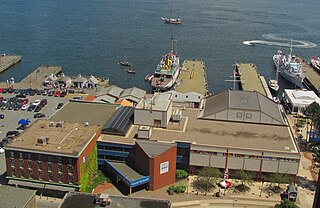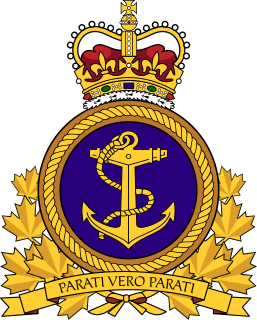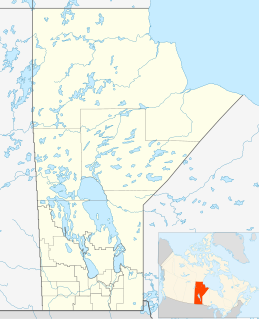
The Maritime Museum of the Atlantic is a maritime museum located in downtown Halifax, Nova Scotia, Canada.

The Royal Canadian Navy is the naval force of Canada. The RCN is one of three environmental commands within the unified Canadian Armed Forces. As of 2017, The Royal Canadian Navy operates 12 frigates, 4 patrol submarines, 12 coastal defence vessels and 8 unarmed patrol/training vessels, as well as several auxiliary vessels. The Royal Canadian Navy consists of 8,500 Regular Force and 5,100 Primary Reserve sailors, supported by 5,300 civilians. Vice-Admiral Art McDonald is the current Commander of the Royal Canadian Navy and Chief of the Naval Staff.
The history of the Royal Canadian Navy goes back to 1910, when the naval force was created as the Naval Service of Canada and renamed a year later by King George V. The Royal Canadian Navy (RCN) is one of the three environmental commands of the Canadian Forces. Over the course of its history, the RCN has played a role in the First World War, contributed significantly to the Battle of the Atlantic during the Second World War, and was a part of NATO's force buildup during the Cold War. In 1968, the RCN was amalgamated with the Canadian Army and the Royal Canadian Air Force to form what is today the unified Canadian Armed Forces. The naval force was known as Maritime Command until 2011, when the environmental command was renamed as the Royal Canadian Navy.
The designation Her Majesty's Canadian Ship (HMCS), is applied as a prefix to surface ships in the Royal Canadian Navy and Canadian Joint Operations Command. The similar designation of Her Majesty's Canadian Submarine is applied to submarine vessels.

Canadian Forces Base (CFB) Halifax is Canada's east coast naval base and home port to the Royal Canadian Navy Atlantic fleet, known as Canadian Fleet Atlantic (CANFLTLANT), that forms part of the formation Maritime Forces Atlantic (MARLANT).

Canadian Forces Base Esquimalt is Canada's Pacific Coast naval base and home port to Maritime Forces Pacific and Joint Task Force Pacific Headquarters. As of 2018, 4,411 military personnel and 2,762 civilians work at CFB Esquimalt.

HMCS Tecumseh is a Royal Canadian Navy Reserve division (NRD) located in Calgary, Alberta, Canada Dubbed a stone frigate, HMCS Tecumseh is a land-based naval establishment.

The Military Museums is a reorganization of the former Museum of the Regiments in Calgary, Alberta, announced by Sophie, Countess of Wessex, on June 3, 2006. The new museum comprises the former Museum of the Regiments as well as the relocated Naval Museum of Alberta and an Air Force Wing consisting of artifacts currently being acquired.

The Costume Museum of Canada is dedicated to fashion and clothing. It is located in Winnipeg, Manitoba, Canada.
The Royal Aviation Museum of Western Canada is a museum in Winnipeg, Manitoba, Canada. The museum is temporarily closed for relocation, and is scheduled to reopen in 2021.

The Winnipeg Railway Museum is a non-profit organization operated by volunteers from the Midwestern Rail Association. The museum is located on tracks 1 and 2 within Winnipeg's Via Rail operated Union Station in Manitoba, Canada.

HMCS Chippawa is a Royal Canadian Navy Reserve Division (NRD) located in Winnipeg, Manitoba. Dubbed a stone frigate, HMCS Chippawa is a land-based naval establishment for part-time sailors as well as a local recruitment centre for the Royal Canadian Navy (RCN).

Doreen Patterson Reitsma was the first woman from British Columbia to enter Canada's newly created Postwar Women's Division of the Royal Canadian Navy. She began her basic training on October 2, 1951, at HMCS Cornwallis in Cornwallis, Nova Scotia. She was trained as an elite radio intelligence operator for the wireless communications base at HMC NRS Coverdale. Coverdale was located near the city of Moncton, New Brunswick and was part of the Canada-USA Atlantic High Frequency Direction Finding Network responsible for the collection of military intelligence. Ms. Patterson was chosen to serve a term at the Naval Radio Station at Churchill, Manitoba in 1953-54. Here, she was part of a special force of eleven Wrens trained to live and work in extreme weather conditions. These Wrens are recognized as the only women in the Royal Canadian Navy's history to have ever served at the base in Churchill.

The Canadian Forces Naval Reserve is the Primary Reserve component of the Royal Canadian Navy (RCN). The primary mission of the NAVRES is to force generate sailors and teams for Canadian Armed Forces (CAF) operations, including: domestic safety operations as well as security and defence missions, while at the same time supporting the Navy's efforts in connecting with Canadians through the maintenance of a broad national presence.
John Campbell was a Scottish-born farmer and political figure in Upper Canada. He represented Frontenac in the Legislative Assembly of Upper Canada from 1830 to 1834 as a Reformer.

The Naval Museum of Halifax is a Canadian Forces museum located at CFB Halifax in the former official residence of the Commander-in-Chief of the North America Station (1819–1905). Also known as the "Admiralty House", the residence is a National Historic Site of Canada located in Halifax, Nova Scotia, Canada. The museum collects, preserves and displays the artifacts and history of the Royal Canadian Navy.
Bruce Carlson is a Canadian composer from Manitoba.

Settlers, Rails & Trails Inc. is a community-run, non-profit museum located in Argyle, Manitoba. It exhibits local history, railway and agricultural artifacts and historical information, and it is also home to the Canadian Flag Collection. Argyle is governed by the Rural Municipality of Rockwood, and is located approximately 28 km northwest of Winnipeg, within the Manitoba Capital Region.

870 Naval Air Squadron, also known as VF-870, was a squadron of the Royal Canadian Navy (RCN). It was formed when 803 Naval Air Squadron of the Royal Navy was renumbered to 870 NAS on 1 May 1951. It operated throughout the 1950s and early 1960s before disbanding on 7 September 1962. It was the first RCN squadron to operate jet aircraft.















